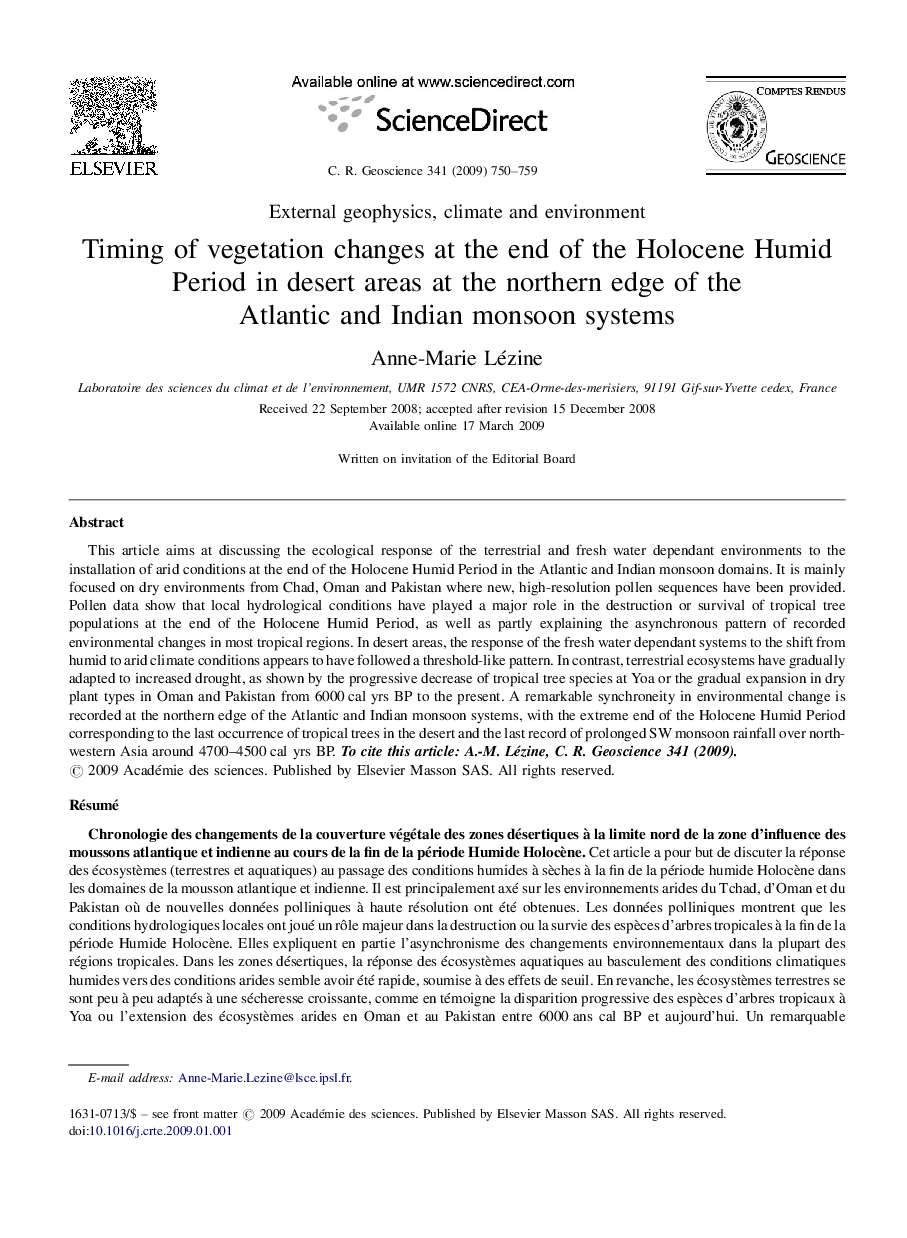| کد مقاله | کد نشریه | سال انتشار | مقاله انگلیسی | نسخه تمام متن |
|---|---|---|---|---|
| 4462633 | 1621572 | 2009 | 10 صفحه PDF | دانلود رایگان |

This article aims at discussing the ecological response of the terrestrial and fresh water dependant environments to the installation of arid conditions at the end of the Holocene Humid Period in the Atlantic and Indian monsoon domains. It is mainly focused on dry environments from Chad, Oman and Pakistan where new, high-resolution pollen sequences have been provided. Pollen data show that local hydrological conditions have played a major role in the destruction or survival of tropical tree populations at the end of the Holocene Humid Period, as well as partly explaining the asynchronous pattern of recorded environmental changes in most tropical regions. In desert areas, the response of the fresh water dependant systems to the shift from humid to arid climate conditions appears to have followed a threshold-like pattern. In contrast, terrestrial ecosystems have gradually adapted to increased drought, as shown by the progressive decrease of tropical tree species at Yoa or the gradual expansion in dry plant types in Oman and Pakistan from 6000 cal yrs BP to the present. A remarkable synchroneity in environmental change is recorded at the northern edge of the Atlantic and Indian monsoon systems, with the extreme end of the Holocene Humid Period corresponding to the last occurrence of tropical trees in the desert and the last record of prolonged SW monsoon rainfall over north-western Asia around 4700–4500 cal yrs BP.
RésuméCet article a pour but de discuter la réponse des écosystèmes (terrestres et aquatiques) au passage des conditions humides à sèches à la fin de la période humide Holocène dans les domaines de la mousson atlantique et indienne. Il est principalement axé sur les environnements arides du Tchad, d’Oman et du Pakistan où de nouvelles données polliniques à haute résolution ont été obtenues. Les données polliniques montrent que les conditions hydrologiques locales ont joué un rôle majeur dans la destruction ou la survie des espèces d’arbres tropicales à la fin de la période Humide Holocène. Elles expliquent en partie l’asynchronisme des changements environnementaux dans la plupart des régions tropicales. Dans les zones désertiques, la réponse des écosystèmes aquatiques au basculement des conditions climatiques humides vers des conditions arides semble avoir été rapide, soumise à des effets de seuil. En revanche, les écosystèmes terrestres se sont peu à peu adaptés à une sécheresse croissante, comme en témoigne la disparition progressive des espèces d’arbres tropicaux à Yoa ou l’extension des écosystèmes arides en Oman et au Pakistan entre 6000 ans cal BP et aujourd’hui. Un remarquable synchronisme est enregistré dans l’évolution de l’environnement, à limite nord de la zone d’influence des moussons atlantique et indienne, à la fin de la période humide holocène, avec la dernière occurrence d’arbres tropicaux dans le désert et le dernier enregistrement prolongé des pluies de la mousson du Sud-Ouest en Asie occidentale à 4700–4500 ans cal BP.
Journal: Comptes Rendus Geoscience - Volume 341, Issues 8–9, August–September 2009, Pages 750–759